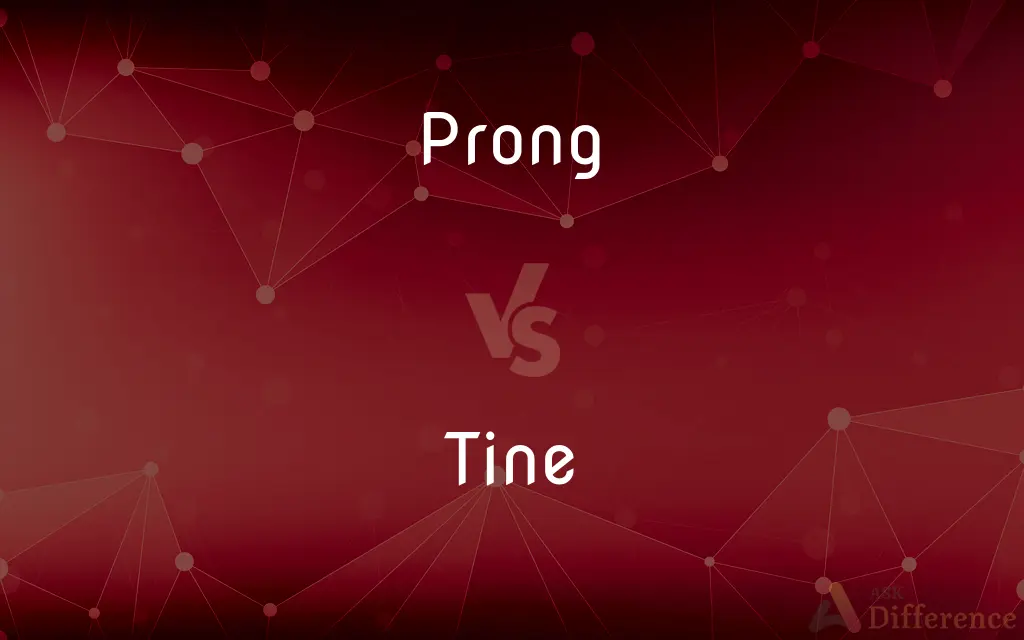Prong vs. Tine — What's the Difference?
Edited by Tayyaba Rehman — By Maham Liaqat — Updated on May 3, 2024
Prong is a general term for any projecting part, used in various contexts, whereas tine specifically refers to the sharp points on tools like forks.

Difference Between Prong and Tine
Table of Contents
ADVERTISEMENT
Key Differences
A prong is a term broadly used to describe any projecting point or sharp spike on objects, including electrical plugs or antenna, enhancing versatility in usage. Whereas, a tine is specifically the pointed spike on utensils like forks or on tools like pitchforks, focusing on functionality in piercing or picking up items.
Prongs are found in various industries, such as jewelry where they hold stones, and in electronics for plug connections. Tines, on the other hand, are predominantly seen in dining and agricultural settings, designed for effective grabbing and holding of materials like hay or food.
The design of prongs can vary significantly depending on their application, ranging from blunt ends in electrical adapters to sharp ends in climbing gear. Tines are usually uniformly sharp and slender, optimized for penetrating or scooping materials.
In terms of strength, prongs may be designed to withstand electrical currents or mechanical stress depending on their use. Tines need to be strong enough to pierce through tough materials like meat or compact soil without bending.
Safety considerations for prongs include insulation and resistance to bending or breaking under pressure, ensuring they can be handled without risk. Tines, while needing to be sharp for functionality, also incorporate safety features to prevent unwanted injuries during their use.
ADVERTISEMENT
Comparison Chart
Definition
A projecting part or pointed spike
A sharp point on utensils or tools
Common Usage
Jewelry, electronics, climbing gear
Forks, pitchforks
Design Variation
Wide, can be blunt or sharp
Uniformly sharp and slender
Strength Needs
Varies: electrical to mechanical
High, for penetrating tough materials
Safety Features
Insulation, structural integrity
Sharp yet safe to handle
Compare with Definitions
Prong
An element of a fork or plug.
She bent a prong on her plug and it wouldn't fit in the socket anymore.
Tine
A sharp, pointed end of a fork or similar tool.
He used the tine of his fork to check if the meat was tender.
Prong
Used in climbing to aid grip.
The prongs on his climbing shoes helped him secure a better foothold.
Tine
Part of a pitchfork or agricultural tool.
The farmer's pitchfork had four strong tines.
Prong
A projecting spike typically used to hold or secure objects.
The jeweler carefully set the diamond using the tiny prongs.
Tine
Used in gardening tools to aerate soil.
The tines on her garden rake made it easy to smooth the soil.
Prong
Part of an animal’s antlers.
The deer's impressive antlers featured several sharp prongs.
Tine
Essential for effective grasping or piercing in culinary settings.
The tine made it simple to pick up the olives.
Prong
A branch of a river or decision point.
The river's prong led to a serene, unexplored area.
Tine
Involvement in food preparation or serving.
She arranged the salad neatly with a tine.
Prong
A thin, pointed, projecting part
A pitchfork with four prongs.
Tine
A branch of a deer's antlers.
Prong
A branch; a fork
The two prongs of a river.
Tine
A prong on an implement such as a fork or pitchfork.
Prong
To pierce with or as if with a thin, pointed, projecting part.
Tine
A spike or point on an implement or tool, especially a prong of a fork or a tooth of a comb.
Prong
A thin, pointed, projecting part, as of an antler or a fork or similar tool. A tine.
A pitchfork with four prongs
Tine
A small branch, especially on an antler or horn.
Prong
A branch; a fork.
The two prongs of a river
Tine
(dialect) A wild vetch or tare.
Prong
(colloquial) The penis.
Tine
(obsolete) Trouble; distress; teen.
Prong
To pierce or poke with, or as if with, a prong.
Tine
Small, diminutive
Prong
A sharp-pointed instrument.
Prick it on a prong of iron.
Tine
To kindle; to set on fire.
Prong
The tine of a fork, or of a similar instrument; as, a fork of two or three prongs.
Tine
(obsolete) To rage; to smart.
Prong
A sharp projection, as of an antler.
Tine
To shut in, or enclose.
Prong
A pointed projection
Tine
Trouble; distress; teen.
Tine
A tooth, or spike, as of a fork; a prong, as of an antler.
Tine
To kindle; to set on fire.
Coals of contention and hot vengeance tind.
Tine
To kindle; to rage; to smart.
Ne was there slave, ne was there medicineThat mote recure their wounds; so inly they did tine.
Tine
To shut in, or inclose.
Tine
Prong on a fork or pitchfork or antler
Common Curiosities
What materials are tines typically made from?
Tines are typically made from metals that are durable and capable of piercing tough materials.
Do prongs on a plug serve a mechanical purpose?
Yes, the prongs on a plug ensure a secure electrical connection with the socket.
Are prongs safe to handle in electrical settings?
Prongs in electrical settings are designed with safety features like insulation to ensure they are safe to handle.
How does the design of prongs vary?
The design of prongs varies widely, from blunt ends for safety in electrical plugs to sharp ends for grip in climbing gear.
Are prongs or tines better for picking up food?
Tines, being sharp and slender, are generally better for efficiently picking up food.
How many prongs are typical on a plug?
Typically, plugs have two or three prongs depending on the need for grounding.
Why are tines important in agricultural tools?
Tines help in effectively grabbing and managing materials like hay or straw in agricultural settings.
What is a prong used for in jewelry?
In jewelry, a prong is used to hold and secure gemstones in place.
Can tines be found on tools other than eating utensils?
Yes, tines are also found on agricultural tools like pitchforks and on gardening tools.
What is the main functional difference between a prong and a tine?
The main difference is that prongs serve various securing and connecting functions, while tines are specifically for piercing and picking up materials.
Are there any cultural or decorative uses for prongs or tines?
Yes, both prongs and tines can be featured in decorative items or cultural artifacts, often symbolizing utility and design.
How does the strength requirement of prongs compare to tines?
Prongs need to be strong enough to handle their specific tasks, like electrical currents, whereas tines need strength primarily for penetrating tough materials.
Can prongs be adjusted or modified?
Yes, prongs, especially in jewelry, can be adjusted to better fit the stones they hold.
Are tines replaceable if they break?
Yes, on many tools, tines can be replaced if they break or wear out.
What safety features are incorporated in tines?
Tines are designed to be sharp yet have features to prevent injury, such as smooth edges or protective coatings.
Share Your Discovery

Previous Comparison
Caipirinha vs. Daiquiri
Next Comparison
Sharp vs. SmartAuthor Spotlight
Written by
Maham LiaqatEdited by
Tayyaba RehmanTayyaba Rehman is a distinguished writer, currently serving as a primary contributor to askdifference.com. As a researcher in semantics and etymology, Tayyaba's passion for the complexity of languages and their distinctions has found a perfect home on the platform. Tayyaba delves into the intricacies of language, distinguishing between commonly confused words and phrases, thereby providing clarity for readers worldwide.
















































